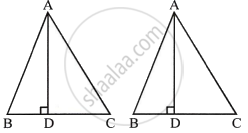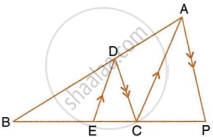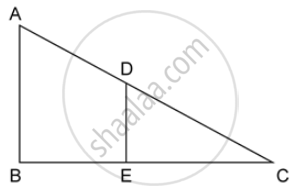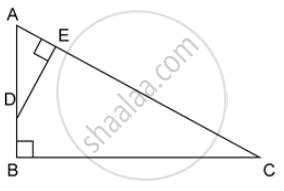Advertisements
Advertisements
Question
Triangle ABC is similar to triangle PQR. If AD and PM are altitudes of the two triangles, prove that : `(AB)/(PQ) = (AD)/(PM)`.
Solution
Given, ΔABC ∼ ΔPQR
AD and PM are altitudes of these two triangles

To prove: `(AB)/(PQ) = (AD)/(PM)`
Proof: Since, ΔABC ∼ ΔPQR
∴ ∠B = ∠Q
`(AB)/(PQ) = (BC)/(QR)`
Now in ΔABD and ΔPQM
∠B = ∠Q
∠D = ∠M ...(Each 90°)
∴ ΔABD ∼ ΔPQM ...(AAS axiom)
∴ `(AB)/(PQ) = (AD)/(PM)` ...(Corresponding sides of Δ's are proportional)
APPEARS IN
RELATED QUESTIONS
State, true or false:
The diagonals of a trapezium divide each other into proportional segments.
In quadrilateral ABCD, diagonals AC and BD intersect at point E such that
AE : EC = BE : ED. Show that: ABCD is a trapezium.
In the figure, given below, straight lines AB and CD intersect at P; and AC || BD. Prove that: If BD = 2.4 cm, AC = 3.6 cm, PD = 4.0 cm and PB = 3.2 cm; find the lengths of PA and PC.

In a trapezium ABCD, side AB is parallel to side DC; and the diagonals AC and BD intersect each other at point P. Prove that :
- ΔAPB is similar to ΔCPD.
- PA × PD = PB × PC.
In a trapezium ABCD, side AB is parallel to side DC; and the diagonals AC and BD intersect each other at point P. Prove that : PA x PD = PB x PC.
In quadrilateral ABCD, the diagonals AC and BD intersect each other at point O. If AO = 2CO and BO = 2DO; show that: ΔAOB is similar to ΔCOD.
In the following figure, DE || AC and DC || AP. Prove that : `(BE)/(EC) = (BC)/(CP)`.

In the given figure, AB and DE are perpendiculars to BC.
If AB = 6 cm, DE = 4 cm and AC = 15 cm. Calculate CD.

ABC is a right angled triangle with ∠ABC = 90°. D is any point on AB and DE is perpendicular to AC. Prove that :

Find, area of ΔADE : area of quadrilateral BCED.
Triangles ABC and DEF are similar.
If area (ΔABC) = 36 cm2, area (ΔDEF) = 64 cm2 and DE = 6.2 cm, find AB.
